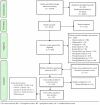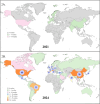This is a preprint.
Global Prevalence of Long COVID, its Subtypes and Risk factors: An Updated Systematic Review and Meta-Analysis
- PMID: 39830235
- PMCID: PMC11741453
- DOI: 10.1101/2025.01.01.24319384
Global Prevalence of Long COVID, its Subtypes and Risk factors: An Updated Systematic Review and Meta-Analysis
Abstract
Importance: Updated knowledge regarding the global prevalence of long COVID (or post-COVID-19 condition), its subtypes, risk factors, and variations across different follow-up durations and geographical regions is necessary for informed public health recommendations and healthcare delivery.
Objective: The primary objective of this systematic review is to evaluate the global prevalence of long COVID and its subtypes and symptoms in individuals with confirmed COVID-19 diagnosis, while the secondary objective is to assess risk factors for long COVID in the same population.
Data sources: Studies on long COVID published from July 5, 2021, to May 29, 2024, searched from PubMed, Embase, and Web of Science were used for this systematic review. Supplemental updates to the original search period were made.
Study selection: There were four inclusion criteria: (1) human study population with confirmed COVID-19 diagnosis; (2) appropriate index diagnosis date; (3) outcome must include either prevalence, risk factors, duration, or symptoms of long COVID; and (4) follow-up time of at least two months after the index date. The exclusion criteria were: (1) non-human study population; (1) case studies or reviews; (2) studies with imaging, molecular, and/or cellular testing as primary results; (3) studies with specific populations such as healthcare workers, residents of nursing homes, and/or those living in long-term care facilities; and (4) studies that did not meet the sample size threshold needed to estimate overall prevalence with margin of error of 0.05.
Data extraction and synthesis: Two screeners independently performed screenings and data extraction, and decision conflicts were collectively resolved. The data were pooled using a random-effects meta-analysis framework with a DerSimonian-Laird inverse variance weighted estimator.
Main outcomes and measures: The primary estimand (target population parameter of interest) was the prevalence of long COVID and its subtypes among individuals with confirmed COVID-19 diagnoses, and the secondary estimand was effect sizes corresponding to ten common risk factors of long COVID in the same population.
Results: A total of 442 studies were included in this mega-systematic review, and 429 were meta-analyzed for various endpoints, avoiding duplicate estimates from the same study. Of the 442 studies, 17.9% of the studies have a high risk of bias. Heterogeneity is evident among meta-analyzed studies, where the I 2 statistic is nearly 100% in studies that estimate overall prevalence. Global estimated pooled prevalence of long COVID was 36% among COVID-19 positive individuals (95% confidence interval [CI] 33%-40%) estimated from 144 studies. Geographical variation was observed in the estimated pooled prevalence of long COVID: Asia at 35% (95% CI 25%-46%), Europe at 39% (95% CI 31%-48%), North America at 30% (95% CI 24%-38%), and South America at 51% (95% CI 35%-66%). Stratifying by follow-up duration, the estimated pooled prevalence for individuals with longer follow-up periods of 1 to 2 years (47% [95% CI 37%-57%]) compared to those with follow-up times of less than 1 year (35% [95% CI 31%-39%]) had overlapping CI and were therefore not statistically distinguishable. Top five most prevalent long COVID subtypes among COVID-19 positive cases were respiratory at 20% (95% CI 14%-28%) estimated from 31 studies, general fatigue at 20% (95% CI 18%-23%) estimated from 121 studies, psychological at 18% (95% CI 11%-28%) estimated from 10 studies, neurological at 16% (95% CI 8%-30%) estimated from 23 studies, and dermatological at 12% (95% CI 8%-17%) estimated from 10 studies. The most common symptom based on estimated prevalence was memory problems estimated at 11% (95% CI 7%-19%) meta-analyzed from 12 studies. The three strongest risk factors for long COVID were being unvaccinated for COVID-19, pre-existing comorbidity, and female sex. Individuals with any of these risk factors had higher odds of having long COVID with pooled estimated odds ratios of 2.34 (95% CI 1.49-3.67) meta-analyzed from 6 studies, 1.59 (95% CI 1.28-1.97) from 13 studies, and 1.55 (95% CI 1.25-1.92) from 22 studies, respectively.
Conclusions and relevance: This study shows long COVID is globally prevalent in the COVID-19 positive population with highly varying estimates. The prevalence of long COVID persists over extended follow-up, with a high burden of symptoms 1 to 2 years post-infection. Our findings highlight long COVID and its subtypes as a continuing health challenge worldwide. The heterogeneity of the estimates across populations and geographical regions argues for the need for carefully designed follow-up with representative studies across the world.
Conflict of interest statement
Conflict of Interest Disclosures Authors have no competing interests.
Figures





Similar articles
-
Deployment of personnel to military operations: impact on mental health and social functioning.Campbell Syst Rev. 2018 Jun 1;14(1):1-127. doi: 10.4073/csr.2018.6. eCollection 2018. Campbell Syst Rev. 2018. PMID: 37131363 Free PMC article.
-
Small class sizes for improving student achievement in primary and secondary schools: a systematic review.Campbell Syst Rev. 2018 Oct 11;14(1):1-107. doi: 10.4073/csr.2018.10. eCollection 2018. Campbell Syst Rev. 2018. PMID: 37131395 Free PMC article.
-
Reducing unemployment benefit duration to increase job finding rates: a systematic review.Campbell Syst Rev. 2018 Feb 28;14(1):1-194. doi: 10.4073/csr.2018.2. eCollection 2018. Campbell Syst Rev. 2018. PMID: 37131392 Free PMC article.
-
Voluntary work for the physical and mental health of older volunteers: A systematic review.Campbell Syst Rev. 2020 Oct 23;16(4):e1124. doi: 10.1002/cl2.1124. eCollection 2020 Dec. Campbell Syst Rev. 2020. PMID: 37016617 Free PMC article. Review.
-
The effect of exposure to long working hours on stroke: A systematic review and meta-analysis from the WHO/ILO Joint Estimates of the Work-related Burden of Disease and Injury.Environ Int. 2020 Sep;142:105746. doi: 10.1016/j.envint.2020.105746. Epub 2020 Jun 3. Environ Int. 2020. PMID: 32505015
References
-
- WHO Coronavirus (COVID-19) Dashboard. Available at: https://covid19.who.int. Assessed 27, December, 2024.
-
- Sudre CH, Murray B, Varsavsky T, et al. Attributes and predictors of long COVID [published correction appears in Nat Med. 2021 Jun;27(6):1116. doi: 10.1038/s41591-021-01361-2]. Nat Med. 2021;27(4):626–631. doi:10.1038/s41591-021-01292-y. - DOI - DOI - PMC - PubMed
Publication types
Grants and funding
LinkOut - more resources
Full Text Sources
